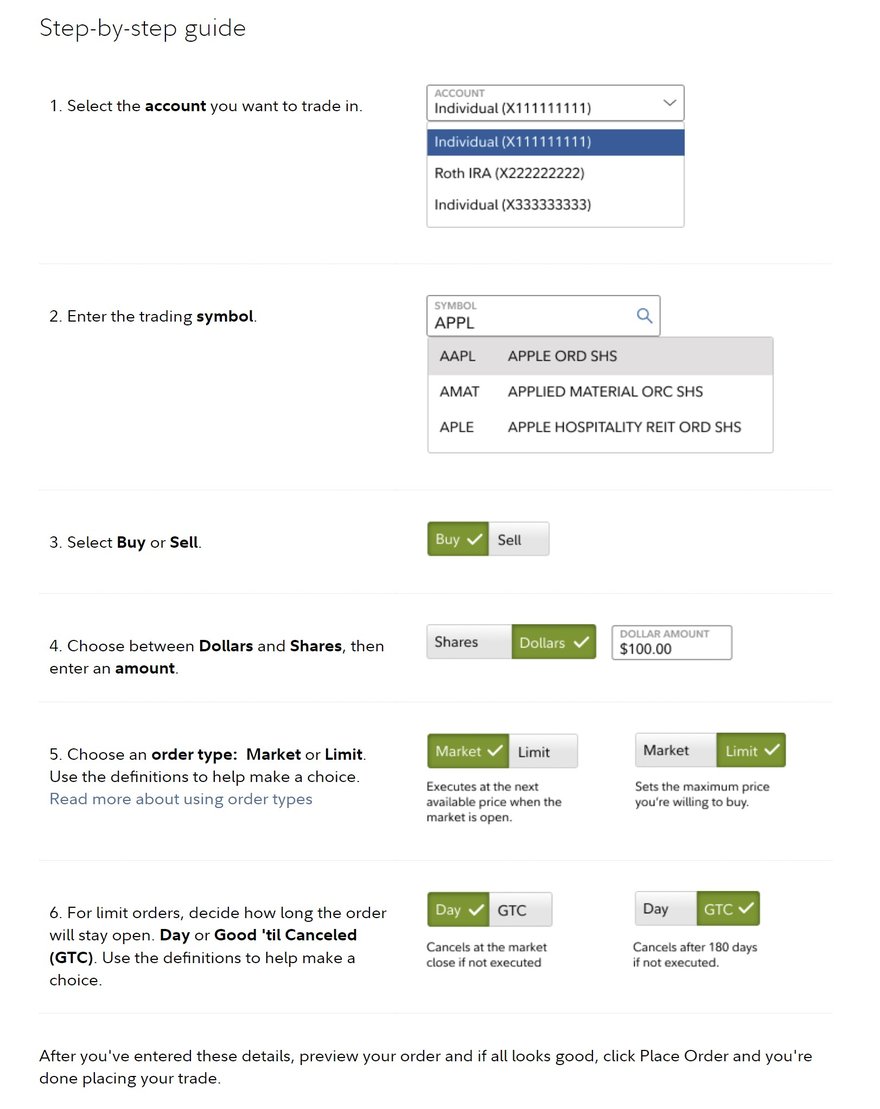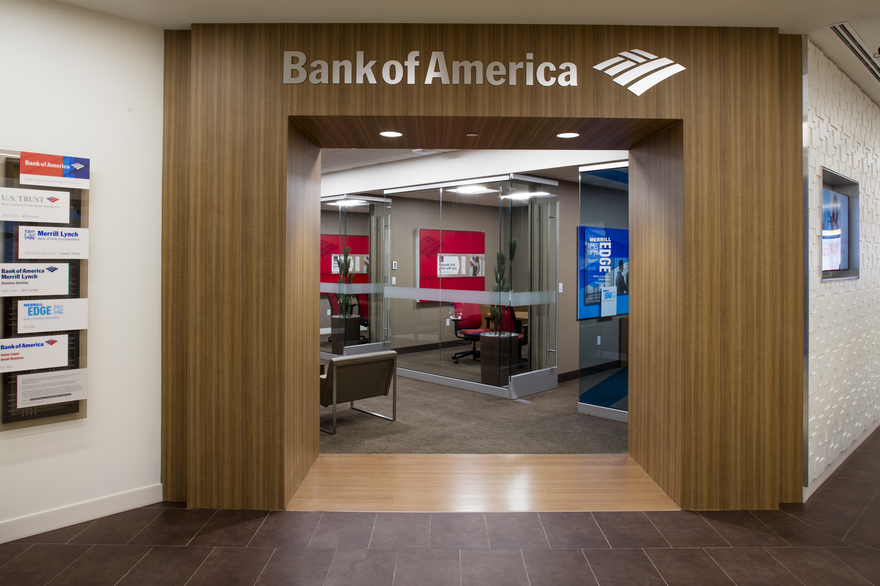Charlotte-based Bank of America (BAC -0.21%) is the second-largest financial institution in the U.S. and one of the world's largest banks. This article will provide an overview of Bank of America's business and the economics of its operations and explain how to buy Bank of America stock.
How to buy
How to buy Bank of America stock
To buy a stock, such as Bank of America, investors must follow a few general steps.
Stock
Step 1: Open a brokerage account
First, investors will need to open a brokerage account. Fidelity has a good online brokerage platform (a screenshot of its trading process is included below). Once investors have a brokerage account, they can deposit money into it. But how much money should investors deposit into their brokerage accounts? Well, that's step two.
Step 2: Figure out your budget
The budget will differ for all investors since everyone's financial situation is unique. However, all investors must ensure their investment budget isn't too big. After all, nothing is guaranteed in the stock market. Investing too much money can put investors under extreme financial strain if things go wrong.
Step 3: Do your research
Third, it's imperative to research all stocks before buying them. Investors want to research bank stocks generally to get an understanding of how the industry works. Once they have a general understanding of bank stocks, they might turn their attention to Bank of America stock to see how it's competing in this space and whether it's making the right moves to create long-term shareholder value.
Step 4: Place an order
Fourth and finally, investors must place an order in their brokerage accounts. The screenshot below is from Fidelity's platform, but all platforms will likely have similar setups.

Here are the main elements in placing a trade: Investors need to input the desired ticker symbol (for Bank of America, it's BAC), select whether the trade is a buy or a sell, and indicate whether it's a market order or a limit order. A market order will be for whatever the price per share happens to be at that particular moment, while a limit order is for a specific price of the investor's choosing.
When selecting a limit order, investors need to clarify whether or not the order is to stay open until it goes through. Investors can input the desired price per share of the trade, but it might not hit that price right away, or ever for that matter.
Should I invest?
Should I invest in Bank of America?
Deciding which stocks to add to a diversified investment portfolio is a personal decision. There's no clear "yes" or "no" response or one-size-fits-all answer.
However, many investors want to outperform the stock-market average with their stock picks. For this reason, I believe it's important to mention that Bank of America stock has underperformed the S&P 500 over the last five-, 10-, and 20-year periods as of this writing. This might cause investors to avoid this stock.
Bank of America stock isn't doomed to underperform in the future just because it's underperformed in the past. Bank of America is a strong and stable business, and some investors simply appreciate the stability that one of the biggest bank stocks in the world can bring to their portfolios.
Regarding stability, Bank of America's business benefits in several ways. For starters, it's what's known as a universal bank, meaning it has both commercial and investment operations.
Performance can be negatively affected by factors outside the company's control, including interest rates and consumer spending. However, as a diversified business, Bank of America is more stable than smaller, more niche financial institutions.
Bank of America also divides its business into four primary segments: consumer banking, global wealth and investment management, global banking, and global markets. Anything that doesn't fit into these categories gets lumped together in a fifth segment called "other."
Bank of America offers services like savings accounts and loan products within its consumer banking and global banking divisions. It also offers investing services in its global wealth and investment management segment. For example, investors could use brokerage services from Bank of America's Merrill Edge instead of Fidelity. And its global markets segment exposes investors to the commodities market.
With such diverse operations, a lot could go wrong for Bank of America, and it takes skill to ensure holistic corporate health. But it appears to be doing well in this department.

For evidence, consider that U.S. banks are assessed annually
by regulators to determine the health of each if severe adverse economic conditions arise. This is known as a stress test, which Bank of America consistently passes. It passed again in 2023, which could be another reason for investors to like its stock.
Bank of America stock could certainly have upside in the future for various reasons. Facing economic uncertainty, management is disciplined with expenses, which can boost profits. Additionally, the company is benefitting from high interest rates and could generate more cash than expected if rates stay higher for longer than anticipated.
Profitability
Is Bank of America profitable?
When investing in bank stocks, investors should consider the economics of each bank to see how profitable it is. In Bank of America's case, it's quite profitable.
As of November 2023, Bank of America had earned more than $30 billion in net income over the previous four quarters, only about 5% less than its all-time high for net income in a 12-month period. And it's achieving these highly profitable results despite setting more money aside for credit losses -- a line item that reduces net income.
Indeed, when borrowers fail to repay their loans, bank profits get hurt, which can be one of the most significant ways Bank of America's profits can take a hit. It usually happens with increased frequency during a slowing or receding economy.
And while high interest rates can help Bank of America with its net interest income, higher rates can also stifle new loan demand by slowing down its business. Bank of America investors should watch these areas. But with profits near all-time highs, this isn't an immediate concern.
Dividends
Does Bank of America pay a dividend?
Yes, Bank of America stock pays a quarterly dividend and has paid a dividend every year for decades. However, the Great Recession severely affected the dividend. And afterward, financial reforms limited some of its autonomy in this area. Still, Bank of America's dividend has steadily increased over the past decade, with management frequently increasing the payout at a double-digit percentage rate.
ETF options
ETFs with exposure to Bank of America
Researching and picking individual stocks is a lot of work, and some investors simply don't have the time or desire. That's OK. And for these investors, a bank exchange-traded fund (ETF) may be the best option. ETFs offer investors a portfolio of stocks based on a theme, in this case, banking.
Exchange-Traded Fund (ETF)
Choosing a bank ETF would still provide investors with outsize exposure to Bank of America stock. One option is the First Trust Nasdaq Bank ETF (FTXO -0.13%). This ETF holds the largest bank stocks on the market. And Bank of America is worth more than 8% of the portfolio's value as of November 2023.
Another option for investors who don't need as much exposure to Bank of America stock is the iShares U.S. Financial Services ETF (IYG -0.03%). This ETF holds a broader portfolio of financial stocks, extending beyond just the big banks. But Bank of America stock is still a prominent component of the ETF, with an almost 5% weighting.
Although these ETFs provide solid exposure to the world of financial stocks and offer instant diversification, it's worth pointing out that both have underperformed the S&P 500 over the last five years, as has Bank of America stock.
Stock splits
Will Bank of America stock split?
In mid-2004, Bank of America stock announced a 2-for-1 stock split. This happens to be its most recent stock split and may provide clues as to whether Bank of America stock will split again.
To be clear, Bank of America's management hasn't communicated a plan to split its stock as of November 2023, so you won't find it on the calendar of upcoming stock splits. Investors need to use logic to determine whether Bank of America stock will split in the future.
In 2004, when Bank of America announced its 2-for-1 stock split, it was trading at more than $80 per share. We can assume management thought the price was too high and preferred to have its shares trade closer to $40.
As of this writing, Bank of America stock trades at about $30 per share, which is close to management's ideal price. So, it's unlikely that Bank of America stock will split in the near future. It would probably have to increase substantially before splitting again.
Related investing topics
The bottom line on Bank of America
Bank of America is a massive financial institution with many ways to make money and grow. It's this diversity that allows it to earn a profit consistently despite macroeconomic conditions.
While it hasn't provided its shareholders with market-beating gains in recent years, returns have been positive, and it's still well positioned to thrive over the long term. For this reason, it could make sense for some investors to buy and hold Bank of America stock in a well-diversified portfolio.
FAQs
Investing in Bank of America FAQs
Is Bank of America a good investment?
Bank of America stock has underperformed the market average in recent years, meaning many of its shareholders would likely say it's not been a good investment. Still, returns have generally been positive over the last decade, so it hasn't been a bad investment either. The company is also in a strong financial position for the future, so the stock could perform better in the coming years.
How do you buy Bank of America stock?
Investors can buy Bank of America stock like they can buy shares of any publicly traded company. They must fund a brokerage account and then buy shares of Bank of America through the brokerage's stock-trading features.
How do I invest money to make money?
There are many ways to invest money to make money. One of the best methods is to buy ownership stakes in appreciating assets. When investors buy a stock, they buy an ownership stake in the underlying business, which is an asset.
Generally speaking, if the business performs well and grows, that ownership stake becomes more valuable. The stock market is a way to invest money to make money.
That said, the stock market does have risks, and nothing is guaranteed. Many investors also lose money in the stock market because their ownership stakes become less valuable. A shrinking business opportunity, increased competition, and mismanagement are reasons a company might become less valuable over time.
































































































































































































































